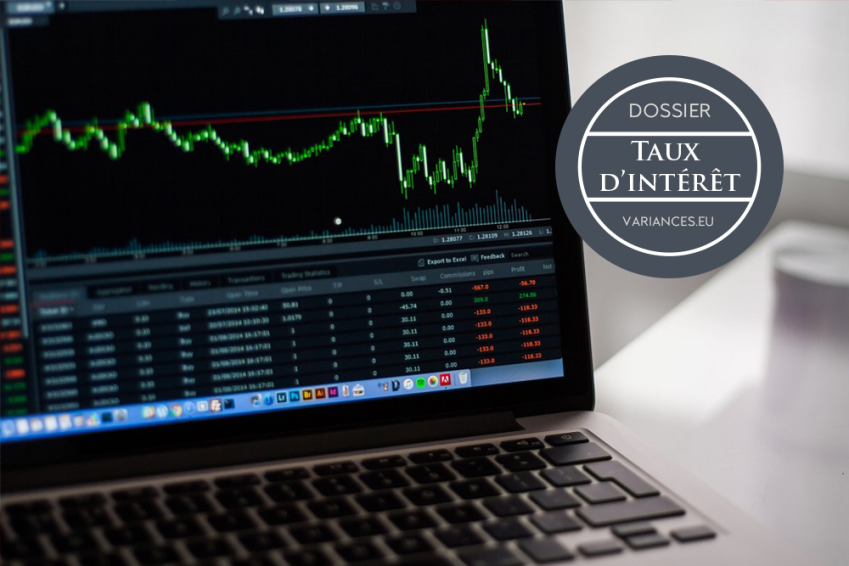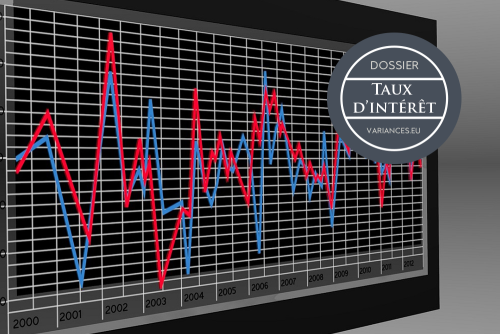
Liste des articles



Vue 37 fois
14 juin 2019
How are institutional investors reacting to low interest rates?
Publié par
Marie Brière
| Taux d'intérêt
Cette interview est tirée du Cahier Louis Bachelier n°32, intitulé : Les défis imposés par la faiblesse des taux d’intérêt, publié en mars 2019.
The low interest rate environment is a challenge for investors who need to reorient their investment strategies towards more profitable asset classes. This difficult situation, by no means devoid of financial risks, is addressed by Marie Brière, whose standpoint is particularly interesting in lying between the professional and academic spheres (see Biography). Interview.
Institut Louis Bachelier: The current low level of interest rates seems to be unprecedented. Is this really so?
Marie Brière: The decline in long-term interest rates has been a trend since the 1980s. We have moved from a very high interest rate regime in the 1970s, marked by two inflationary events (the 1973 and 1979 oil shocks), to a new regime in which rates are structurally lower. This gradual and generalized shift began in the 1980s during the «Great Moderation», during which the main macroeconomic variables, including growth and inflation, were less volatile. Today, 17% of all bonds issued come with negative rates (Deutsche Bank, 2018). This exceptional situation, a consequence of the subprime crisis and the unconventional monetary policies that followed, may well continue.
What are the implications of low interest rates for institutional investors?
MB: The performance of the traditional asset classes, namely equities and bonds, has been reduced due to lower risk-free interest rates and the compression of risk premiums, related in particular to investors’ search for yield. Investors are opting for riskier and less liquid assets, thus increasing prices and squeezing their expected returns. The low interest rate environment also affects the balance sheets of institutional investors, in particular insurers and pension funds, which have commitments embodied in their liabilities.
To what extent are the balance sheets of institutional investors under pressure?
MB: In the balance sheet of insurance companies and pension funds, the assets invested are performing less well, while the fall in rates automatically increases the value of liabilities, discounted at market value with the current accounting and prudential regulations. According to the latest stress tests on pension funds in Europe, carried out in 2017 by the European Insurance and Occupational Pensions Authority (EIOPA), the overall underfunding of occupational pension funds was estimated at 349 billion euros, or an average deficit of around 20% of the value of liabilities, with significant disparities from country to country.
Are the regulations at fault?
MB: The regulators are not the cause of the current difficulties faced by pension funds. Rather pension funds balance sheets have deteriorated because of low interest rates, as well as from the increasing life expectancy of beneficiaries. However, prudential regulations that require regulatory capital to be set aside in the event of an imbalance between assets and liabilities, together with accounting standards oriented towards marked-to-market valuations, naturally accentuate the problems, even though they did not trigger them.
So how are insurance companies and pension funds reacting?
MB: We are seeing is a structural shift towards a reduction in the guarantees offered, with a transfer of risks to individuals. This is evident with insurance companies, which now prefer to sell unit-linked contracts rather than euro funds with guaranteed capital. It is similar with regard to pension funds. In some countries (US, UK, Switzerland), there has been a shift from funds with defined benefits to defined contributions pension funds. In the Netherlands and the United Kingdom, we are witnessing the creation of «hybrid» funds, where risks are shared between the pension fund’s sponsoring company and the contributing employees, who are the future beneficiaries. In such cases, retirement pensions may depend on the performance of the financial markets or on changes in longevity. This sharing of risks can be quite effective, and even relatively attractive for individuals (on this topic see Boon, Brière and Werker, 2018)[1], and it limits financial institutions’ costly requirement for regulatory capital.
What are the consequences for individuals?
MB: The consequence of this phenomenon is a reallocation of risks towards individuals, since financial institutions play the role of financial intermediation and distribute financial products with more limited risk of loss. The low rates also have implications for intergenerational risk sharing, with a potential reduction of benefits larger for younger generations compared to older generations. Lastly, we can expect an increase in the supply of work and savings demand and a redistribution of wealth (see the paper by Horneff, Maurer and Mitchell (2018), presented at the Financial Risks International Forum)[2].
Let’s go back to institutional investors. What are their strategies for generating returns?
MB: Investors have been turning much more towards alternative assets since the financial crisis. In recent years, real estate and private equity have benefitted. According to the work of Ivashina and Lerner (2018)[3], also presented at the Financial Risks International Forum, there has been a large reallocation towards alternative assets, which are supposed to be more remunerative, because they are less liquid. There is, however, a debate within the academic community about this asset class. Does the extra return over liquid assets remunerate a liquidity premium or instead a higher risk that is poorly measured because of the relative lack of transactions data? Although this question has not been settled, investors nonetheless are moving massively in this direction, as evidenced by the rise in outstanding assets invested on this asset class in developed countries, which increased by 63% between 2008 and 2017, according to the study mentioned above.
Another investor trend is the adoption of active systematic smart beta or factor strategies that outperform passive strategies. Active strategies are, in fact, supposed to capture additional risk premiums and therefore higher returns.
Do these new strategies generate more risk?
MB: Passive strategies based on traditional indexes weighted by market capitalization induce hardly any portfolio turnover, unlike systematic active strategies. The risk lies in investors’ possible herd behaviour (the crowding effect). If they adopt similar active strategies in buying and selling the same securities, this may accentuate funding risk in the case of coincident clients’ redemption requests, and hence potentially stronger coincident price declines in the markets. As shown by the work of Fontaine, Garcia and Gungor in 2016[4], and Cho in 2019[5], equity markets have been more exposed to such funding risk since the mid-1990s.
Are the risks of contagion higher?
MB: Yes, this can generate new correlations between certain securities that were not linked at all previously.
To conclude, are these investment strategies resulting from low interest rates bubble vectors?
MB: It is always very difficult to show the existence of a bubble before it bursts. Nevertheless, when investors move simultaneously and massively into an asset class, it is obvious that valuations increase sharply, which can result in bubbles that may subsequently burst.
1) Boon, Brière and Werker (2018), “Systematic Longevity Risk: To Bear or to Insure?”, SSRN Working Paper N°2926902.
2) Horneff, Maurer and Mitchell (2018), “How Will Persistent Low Expected Returns Shape Household Economic Behavior”, NBER Working Paper 25133.
3) Ivashina and Lerner (2018), “Looking for Alternatives: Pension Investments around the World, 2008 to 2017”, Working Paper.
4) Fontaine, Garcia and Gungor (2016), “Funding Risk, Market Liquidity, Market Volatility and the Cross Section of Asset Returns”, SSRN Working Paper 2557211.
5) Cho (2019), “Turning Alphas into Betas: Arbitrage and the Cross-Section of Risk”, Paul Woolley Centre Working Paper 61.
The low interest rate environment is a challenge for investors who need to reorient their investment strategies towards more profitable asset classes. This difficult situation, by no means devoid of financial risks, is addressed by Marie Brière, whose standpoint is particularly interesting in lying between the professional and academic spheres (see Biography). Interview.
Institut Louis Bachelier: The current low level of interest rates seems to be unprecedented. Is this really so?
Marie Brière: The decline in long-term interest rates has been a trend since the 1980s. We have moved from a very high interest rate regime in the 1970s, marked by two inflationary events (the 1973 and 1979 oil shocks), to a new regime in which rates are structurally lower. This gradual and generalized shift began in the 1980s during the «Great Moderation», during which the main macroeconomic variables, including growth and inflation, were less volatile. Today, 17% of all bonds issued come with negative rates (Deutsche Bank, 2018). This exceptional situation, a consequence of the subprime crisis and the unconventional monetary policies that followed, may well continue.
What are the implications of low interest rates for institutional investors?
MB: The performance of the traditional asset classes, namely equities and bonds, has been reduced due to lower risk-free interest rates and the compression of risk premiums, related in particular to investors’ search for yield. Investors are opting for riskier and less liquid assets, thus increasing prices and squeezing their expected returns. The low interest rate environment also affects the balance sheets of institutional investors, in particular insurers and pension funds, which have commitments embodied in their liabilities.
To what extent are the balance sheets of institutional investors under pressure?
MB: In the balance sheet of insurance companies and pension funds, the assets invested are performing less well, while the fall in rates automatically increases the value of liabilities, discounted at market value with the current accounting and prudential regulations. According to the latest stress tests on pension funds in Europe, carried out in 2017 by the European Insurance and Occupational Pensions Authority (EIOPA), the overall underfunding of occupational pension funds was estimated at 349 billion euros, or an average deficit of around 20% of the value of liabilities, with significant disparities from country to country.
Are the regulations at fault?
MB: The regulators are not the cause of the current difficulties faced by pension funds. Rather pension funds balance sheets have deteriorated because of low interest rates, as well as from the increasing life expectancy of beneficiaries. However, prudential regulations that require regulatory capital to be set aside in the event of an imbalance between assets and liabilities, together with accounting standards oriented towards marked-to-market valuations, naturally accentuate the problems, even though they did not trigger them.
So how are insurance companies and pension funds reacting?
MB: We are seeing is a structural shift towards a reduction in the guarantees offered, with a transfer of risks to individuals. This is evident with insurance companies, which now prefer to sell unit-linked contracts rather than euro funds with guaranteed capital. It is similar with regard to pension funds. In some countries (US, UK, Switzerland), there has been a shift from funds with defined benefits to defined contributions pension funds. In the Netherlands and the United Kingdom, we are witnessing the creation of «hybrid» funds, where risks are shared between the pension fund’s sponsoring company and the contributing employees, who are the future beneficiaries. In such cases, retirement pensions may depend on the performance of the financial markets or on changes in longevity. This sharing of risks can be quite effective, and even relatively attractive for individuals (on this topic see Boon, Brière and Werker, 2018)[1], and it limits financial institutions’ costly requirement for regulatory capital.
What are the consequences for individuals?
MB: The consequence of this phenomenon is a reallocation of risks towards individuals, since financial institutions play the role of financial intermediation and distribute financial products with more limited risk of loss. The low rates also have implications for intergenerational risk sharing, with a potential reduction of benefits larger for younger generations compared to older generations. Lastly, we can expect an increase in the supply of work and savings demand and a redistribution of wealth (see the paper by Horneff, Maurer and Mitchell (2018), presented at the Financial Risks International Forum)[2].
Let’s go back to institutional investors. What are their strategies for generating returns?
MB: Investors have been turning much more towards alternative assets since the financial crisis. In recent years, real estate and private equity have benefitted. According to the work of Ivashina and Lerner (2018)[3], also presented at the Financial Risks International Forum, there has been a large reallocation towards alternative assets, which are supposed to be more remunerative, because they are less liquid. There is, however, a debate within the academic community about this asset class. Does the extra return over liquid assets remunerate a liquidity premium or instead a higher risk that is poorly measured because of the relative lack of transactions data? Although this question has not been settled, investors nonetheless are moving massively in this direction, as evidenced by the rise in outstanding assets invested on this asset class in developed countries, which increased by 63% between 2008 and 2017, according to the study mentioned above.
Another investor trend is the adoption of active systematic smart beta or factor strategies that outperform passive strategies. Active strategies are, in fact, supposed to capture additional risk premiums and therefore higher returns.
Do these new strategies generate more risk?
MB: Passive strategies based on traditional indexes weighted by market capitalization induce hardly any portfolio turnover, unlike systematic active strategies. The risk lies in investors’ possible herd behaviour (the crowding effect). If they adopt similar active strategies in buying and selling the same securities, this may accentuate funding risk in the case of coincident clients’ redemption requests, and hence potentially stronger coincident price declines in the markets. As shown by the work of Fontaine, Garcia and Gungor in 2016[4], and Cho in 2019[5], equity markets have been more exposed to such funding risk since the mid-1990s.
Are the risks of contagion higher?
MB: Yes, this can generate new correlations between certain securities that were not linked at all previously.
To conclude, are these investment strategies resulting from low interest rates bubble vectors?
MB: It is always very difficult to show the existence of a bubble before it bursts. Nevertheless, when investors move simultaneously and massively into an asset class, it is obvious that valuations increase sharply, which can result in bubbles that may subsequently burst.
1) Boon, Brière and Werker (2018), “Systematic Longevity Risk: To Bear or to Insure?”, SSRN Working Paper N°2926902.
2) Horneff, Maurer and Mitchell (2018), “How Will Persistent Low Expected Returns Shape Household Economic Behavior”, NBER Working Paper 25133.
3) Ivashina and Lerner (2018), “Looking for Alternatives: Pension Investments around the World, 2008 to 2017”, Working Paper.
4) Fontaine, Garcia and Gungor (2016), “Funding Risk, Market Liquidity, Market Volatility and the Cross Section of Asset Returns”, SSRN Working Paper 2557211.
5) Cho (2019), “Turning Alphas into Betas: Arbitrage and the Cross-Section of Risk”, Paul Woolley Centre Working Paper 61.
Autrice

Diplômée de l'ENSAE, docteur en économie
actuellement responsable de la Statégie Taux, Change et Volatilité au Crédit Agricole Asset Management, chercheur associé à PSE (CNRS) et à l'Université Libre de Bruxelles Voir les 2 Voir les autres publications de l’auteur(trice)
actuellement responsable de la Statégie Taux, Change et Volatilité au Crédit Agricole Asset Management, chercheur associé à PSE (CNRS) et à l'Université Libre de Bruxelles Voir les 2 Voir les autres publications de l’auteur(trice)











Aucun commentaire
Vous devez être connecté pour laisser un commentaire. Connectez-vous.